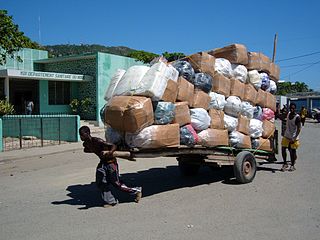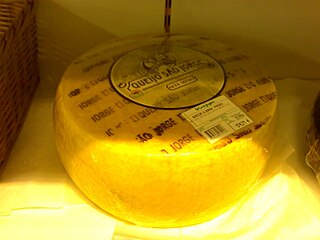This article concerns systems of transport in Lesotho. As a landlocked country, Lesotho has no seaports or harbours, but does have road, air transport, and limited rail infrastructure.

Leonardo di ser Piero da Vinci was an Italian polymath of the High Renaissance who was active as a painter, draughtsman, engineer, scientist, theorist, sculptor, and architect. While his fame initially rested on his achievements as a painter, he also became known for his notebooks, in which he made drawings and notes on a variety of subjects, including anatomy, astronomy, botany, cartography, painting, and paleontology. Leonardo is widely regarded to have been a genius who epitomized the Renaissance humanist ideal, and his collective works comprise a contribution to later generations of artists matched only by that of his younger contemporary Michelangelo.

A wheel is a circular component that is intended to rotate on an axle bearing. The wheel is one of the key components of the wheel and axle which is one of the six simple machines. Wheels, in conjunction with axles, allow heavy objects to be moved easily facilitating movement or transportation while supporting a load, or performing labor in machines. Wheels are also used for other purposes, such as a ship's wheel, steering wheel, potter's wheel, and flywheel.

The Stone of Scone, also known as the Stone of Destiny, is an oblong block of red sandstone that was used originally in the coronation of the monarchs of Scotland and, after the 13th century, the coronation of the monarchs of England, Great Britain and the United Kingdom. It is also known as Jacob's Pillow Stone and the Tanist Stone, and as clach-na-cinneamhain in Scottish Gaelic.

The Last Supper is a mural painting by the Italian High Renaissance artist Leonardo da Vinci, dated to c. 1495–1498. The painting represents the scene of the Last Supper of Jesus with the Twelve Apostles, as it is told in the Gospel of John – specifically the moment after Jesus announces that one of his apostles will betray him. Its handling of space, mastery of perspective, treatment of motion and complex display of human emotion has made it one of the Western world's most recognizable paintings and among Leonardo's most celebrated works. Some commentators consider it pivotal in inaugurating the transition into what is now termed the High Renaissance.

A sled, skid, sledge, or sleigh is a land vehicle that slides across a surface, usually of ice or snow. It is built with either a smooth underside or a separate body supported by two or more smooth, relatively narrow, longitudinal runners similar in principle to skis. This reduces the amount of friction, which helps to carry heavy loads.

A cart or dray is a vehicle designed for transport, using two wheels and normally pulled by one or a pair of draught animals. A handcart is pulled or pushed by one or more people.

A wheelbarrow is a small hand-propelled vehicle, usually with just one wheel, designed to be pushed and guided by a single person using two handles at the rear, or by a sail to push the ancient wheelbarrow by wind. The term "wheelbarrow" is made of two words: "wheel" and "barrow." "Barrow" is a derivation of the Old English "barew" which was a device used for carrying loads.

Dutch cheese farmers traditionally take their cheeses to the town's market square to sell them. Teams (vemen) of official guild cheese-porters (kaasdragers), identified by differently coloured straw hats associated with their forwarding company, carried the farmers' cheese on barrows that weighed about 160 kilograms. Buyers sampled the cheeses and negotiated prices using a ritual system, called handjeklap, whereby buyers and sellers clapped each other's hands and shouted out prices. Once a price was agreed, porters carried the cheese to the weigh house (Waag) and weighed the cheese on a company scale.

Medieval technology is the technology used in medieval Europe under Christian rule. After the Renaissance of the 12th century, medieval Europe saw a radical change in the rate of new inventions, innovations in the ways of managing traditional means of production, and economic growth. The period saw major technological advances, including the adoption of gunpowder, the invention of vertical windmills, spectacles, mechanical clocks, and greatly improved water mills, building techniques, and agriculture in general.

A hand truck, also known as a hand trolley, dolly, stack truck, trundler, box cart, sack barrow, cart, sack truck, two wheeler, or bag barrow, is an L-shaped box-moving handcart with handles at one end, wheels at the base, with a small ledge to set objects on, flat against the floor when the hand-truck is upright. The objects to be moved are tilted forward, the ledge is inserted underneath them, and the objects allowed to tilt back and rest on the ledge. The truck and objects are then tilted backward until the weight is balanced over the wheels, making otherwise bulky and heavy objects easier to move. It is a first-class lever.

Barrow upon Humber is a village and civil parish in North Lincolnshire, England. The population at the 2011 census was 3,022.

A pedalo, pedal boat, or paddle boat is a human-powered watercraft propelled by the action of pedals turning a paddle wheel.

Leonardo da Vinci (1452–1519) was an Italian polymath, regarded as the epitome of the "Renaissance Man", displaying skills in numerous diverse areas of study. While most famous for his paintings such as the Mona Lisa and the Last Supper, Leonardo is also renowned in the fields of civil engineering, chemistry, geology, geometry, hydrodynamics, mathematics, mechanical engineering, optics, physics, pyrotechnics, and zoology.

Museo Nazionale Scienza e Tecnologia Leonardo da Vinci in Milan, dedicated to painter and scientist Leonardo da Vinci, is the largest science and technology museum in Italy. It was opened on 5 February 1953 and inaugurated by Prime Minister Alcide De Gasperi.

Saint Jerome in the Wilderness is an unfinished painting by the Italian Renaissance artist Leonardo da Vinci, dated c. 1480–1490. The composition of the painting has been drafted in monochrome onto the primed wooden panel. At an unknown date after Leonardo's death, the panel was cut into five pieces before eventually being restored into its original form.

São Jorge Cheese is a semi-hard to hard cheese, produced on the island of São Jorge, in the Portuguese archipelago of the Azores, certified as a Região Demarcada do Queijo de São Jorge and regulated as a registered Denominação de Origem Protegida.

The portrait of a man in red chalk in the Royal Library of Turin is widely, though not universally, accepted as a self-portrait of Leonardo da Vinci. It is thought that Leonardo da Vinci drew this self-portrait at about the age of 60. The portrait has been extensively reproduced and has become an iconic representation of Leonardo as a polymath or "Renaissance Man". Despite this, some historians and scholars disagree as to the true identity of the sitter.

Human-powered land vehicles are land vehicles propelled over ground by human power, The main ways to support the weight of a human-powered land vehicle and its contents above the ground are rolling contact; sliding contact; intermittent contact; no contact at all as with anything carried; or some combination of the above. The main methods of using human power to propel a land vehicle are some kind of drivetrain; pushing laterally against the ground with a wheel, skate, or ski that simultaneously moves forward; by pushing against the ground directly with an appendage opposite to the direction of travel; or by propeller. Human-powered land vehicles can be propelled by persons riding in the vehicle or by persons walking or running and not supported by the vehicle.
"A Red Wheelbarrow" is the eighth episode of the third season of the American television drama series Homeland, and the 32nd episode overall. It premiered on Showtime on November 17, 2013.


















